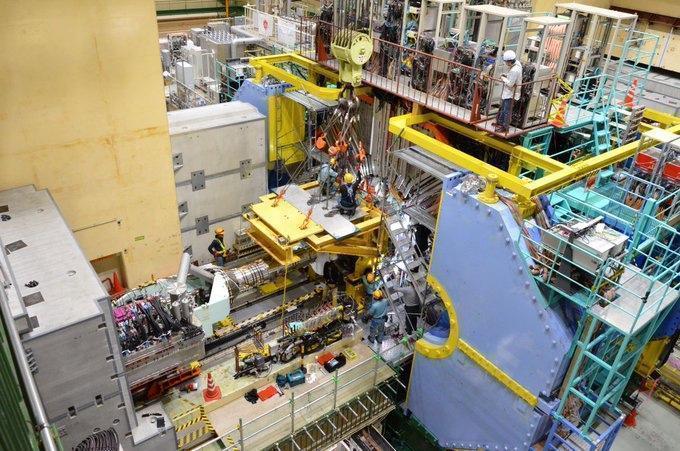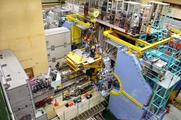Belle II (Experimental Particle Physics)
Belle II (Experimental Particle Physics)
Componenti
- Bianchi Fabrizio Umberto
- Boschetti Alessandro (Dottorando/a)
- Bussa Maria Pia
- Destefanis Marco Giovanni Maria
- Greco Michela
- Maggiora Marco
- Marcello Simonetta
- Mussa Roberto (senior INFN fellow)
- Spataro Stefano Giovanni
- Tamponi Umberto (Ricercatore/Ricercatrice)
Contatti

Settore ERC
Attività
Durante il big bang, materia e antimateria dovrebbero essere state create nella stessa misura. Ma perchè al giorno d'oggi l'Universo è costituito in pratica soltanto di materia? I fisici attribuiscono le differenze tra le caratteristiche di materia e antimateria alla violazione della cosidetta simmetria CP (Carica-Parità). Questa simmetria fondamentale della natura stabilisce che le leggi della fisica non devono cambiare quando una particella viene scambiata con la sua antiparticella, invertendo il segno di tutte le coordinate spaziali. Quanto osservato fino ad ora sulla violazione CP non è sufficiente per spiegare quanto misurato sugli eccessi di materia nell'Universo. L'esperimento Belle II in Giappone si pone l'obiettivo di indagare e risolvere questo importante mistero della fisica delle particelle, assieme ad altri misteri tuttora non risolti...
L'attività del gruppo di Belle II Torino si focalizza su:
- Mantenimento e sviluppo del sistema di calibrazione laser per il rivelatore Time-Of-Propagation detector (TOP), con l'intendo di identificare con elevata precisione il tipo di particelle che lo investono misurando la luce Cherenkov emessa. L'attività riguarda aspetti sia hardare che software, includendo sia le procedure di calibrazione che lo sviluppo di algoritmi di identificazione di particelle
- Studi di fisica per quanto riguarda la spettroscopia di stati di quarkonio, nuova fisica in decadimenti rari dei mesoni B D e dei leptoni tau, e ricerca di materia oscura (Dark Matter) nel settore "leggero" delle basse masse
- Sviluppo di algoritmi di tracciamento di tracce cariche, per raggiungere valori di elevata efficienza di ricostruzione e di risoluzione
- Sviluppo di algoritmi di ricostruzione di anti-neutroni
- Implementazione di una struttura di clpud computing per il calcolo distrìibuito dell'esperimento
- Rivelatore Cherenkov e Identificazione di Particelle: Università di Padova, University of Hawaii
- Tracciamento di particelle cariche: Università di Pisa
- Studi di Fisica: Technical University of Munich - University of Mississippi
Spettroscopia, quarkonio, collisori e+ e-, tracciamento, identificazione di particelle, TOP, rivelatori Cherenkov
In the big bang, matter and antimatter should have been created in equal amounts. But why is the universe today filled almost only with matter? Physicists attribute the different behaviour of matter and antimatter to the violation of the so-called CP symmetry. This fundamental symmetry of nature states that laws of physics should not change when a particle is interchanged with its antiparticle and the signs of all its spatial coordinates are flipped. Still, the extent of the observed CP violation is not sufficient to explain the actual excess of matter in the universe. The Belle II experiment in Japan aims to solve this great mystery of particle physics, together with many other unsolved issues...
The Belle II detector is located in the collision area of the SuperKEKB e+e- collider at the KEK laboratory in Tsukuba, Japan. The Belle II experiment collected in the last years 424 fb-1of integrated luminosity usable for physics. The goal is to reach 50 ab-1 of integrated luminosity within 2030. The SuperKEKB accelerator is now in long shutdown until end 2023 for the accelerator components and the Belle II detector upgrades.
The Belle II collaboration consists of over 1160 physicists and engineers from 130 institutions in 27 countries. Italy participates in Belle II, and in particular the Torino group with involvement in both hardware, software, computing and analysis.
The Italian participation to Belle II is funded by INFN (Istituto Nazionale di Fisica Nucleare).
The Belle II Torino research activities are focused on:
- Maintaining the laser calibration system for the Time-Of-Propagation detector (TOP), aimed at performing high precision particle identification by means of Cherenkov light. This involves both hardare and software activities, including calibration and development of particle identification algorithms
- Perform physics studies involving quarkonium spectroscopy, new physics in rare decays of B, D mesons and tau lepton, and search for Dark Matter in the light sector
- Develope software algorithms for charged particle tracking, in order to achieve high resolution and efficiency
- Developement of algorithm for the reconstruction of anti-neutrons
- Implement a cloud computing infrastructure for the distributed computing of the experiment
- Cherenkov detector and Particle Identification: University of Padua, University of Hawaii
- Charged Particle Tracking: University of Pisa
- Physics Studies: - Technical University of Munich - University of Mississippi
Spectroscopy, quarkonium, e+ e- colliders, tracking, particle identification, TOP, Cherenkov detectors
Prodotti della ricerca
- B-flavor tagging at Belle II - https://iris.unito.it/handle/2318/1880932
- Combined analysis of Belle and Belle II data to determine the CKM angle ϕ 3 using B + → D(KS0 h + h −)h + decays - https://iris.unito.it/handle/2318/1870090
- Search for B^{+}→K^{+}νν[over ¯] Decays Using an Inclusive Tagging Method at Belle II - https://iris.unito.it/handle/2318/1869900
- Precise Measurement of the D^{0} and D^{+} Lifetimes at Belle II - https://iris.unito.it/handle/2318/1870046
- Track finding at Belle II - https://iris.unito.it/handle/2318/1804881
- Search for Axionlike Particles Produced in e+e- Collisions at Belle II - https://iris.unito.it/handle/2318/1804844
- Search for an Invisibly Decaying Z′ Boson at Belle II in e+e- →μ+μ- (e±μ) Plus Missing Energy Final States - https://iris.unito.it/handle/2318/1804670
- Measurement of the integrated luminosity of the Phase 2 data of the Belle II experiment - https://iris.unito.it/handle/2318/1804667





